
There’s no better time to dive into eating more seafood. Tinned fish is having what we thought might be a moment but will likely turn into a chapter; a wider variety of sustainable and BAP-certified (Best Aquaculture Practices) seafood is making it easier to consume it more responsibly; general fatigue has made dinner proteins that cook in minutes especially appealing, as well as any food to help support our tired bodies with omega-3 fatty acids.
Seafood is loaded with healthy nutrients and lean protein, and then there’s the simple fact that when it’s fresh, it’s damn delicious.
But therein lies the caveat: when it’s fresh. The delicate fruits of the sea are highly susceptible to spoilage, sensitive to improper storage, preservation and even thawing. And unless you’re catching it yourself or buying BAP-certified (which allows you to follow its trail), it’s hard to know exactly what kind of journey your seafood had before it arrived at the store.
If your seafood has anything less than the royal treatment, you could suffer through scombroid poisoning — a histamine-producing reaction — as soon as 15 minutes after it enters your digestive tract. That’s why it’s important to be aware of red or even orange flags that good fish is on the cusp of going bad.
1. Lack of visual appeal
The first thing that Okan Kizilbayir, the executive chef for the AAA Five-Diamond Salt at The Ritz-Carlton, Amelia Island, advises is to “just look at it”.
“If you don’t like it, don’t buy it,” he added. And this can extend to how it’s merchandised. The FDA suggests that you “only buy fish that is refrigerated or displayed on a thick bed of fresh ice, preferably in a case or under some type of cover.” This isn’t just to look nice — it helps to regulate the temperature and food safety, and is a good indication of how the seafood is treated.
And if the fish is whole, take a look at its eyes. “Are they clear, hazy or turbid?” asked Eddie Barret, executive chef at Atlanta seafood restaurant BeetleCat. Michael Nelson, executive chef of GW Fins in New Orleans, added another criteria: that the eyes shouldn’t be sunken in, either. “They should appear clear and almost alive and looking back at you.” If there’s anything that sets your Spidey-sense tingling, go elsewhere or pick another fish.
2. Odour
Sometimes, you don’t even need a visual to know to walk away. For many professionals, the sniff test is the first and most important one they conduct.
“A good fishery should smell like the ocean,” Kizilbayir said. “There might be a very bad mussel standing in the corner of the ice and that would ruin the entire smell of the area; this happens all the time.”
Even so, that’s his cue to proceed with some caution and impetus to “get your nose closer to the fish in order to choose the best one.” The less you smell, the better it is, because fresh fish doesn’t actually smell “fishy”; a quick whiff shouldn’t include sour or ammonia-like surprises. “Does it smell gassy, foul or off-putting in any way? That’s the first dead giveaway for us,” Barrett said.
“If you get close enough to smell the inside of the gills, it should only smell of the ocean. It will be a subtle, clean scent,” said Pattie Lawlertratana, chef-owner of Snap Thai Fish House in Atlanta.
3. Squishy, squidgy fish
Getting up close and personal with your seafood is something you oughtn’t be shy about. Reputable purveyors like fishmonger Frank Palermo, owner of Claws Seafood Market, a chemical- and preservative-free seafood shop on Long Island, New York, will stand by their product, so go ahead and ask to give it a good poke.
“There should be resilience to the touch,” he said; “the flesh needs to bounce back a little bit,” Kizilbayir said. That’s because “some fish will break down as they sit, resulting in mushy-feeling fish,” Barrett explained.
Additionally, you want to get your hands on the skin to ensure it’s not slimy, sticky or missing scales, Lawlertratana said. According to Nelson, the former two criteria also applies to fillets. “It’s a sure sign it has spoiled.” However, “a clear, viscous film on the outside is usually a sign that the fish was recently caught,” so be sure not to confuse that with sliminess.
4. Brown gills
“If the gills have started turning brown, that’s a pretty clear sign it’s been sitting. Fresh fish should have reddish-pink gills,” Barrett said. “Or bright red,” Palermo said. “Brown blood or gills are a hard no for me.”
You can also check freshness by the bloodline. “If it has one, like snapper or redfish,” Barrett advised. “If it has some age on it or has been previously frozen, it will appear brown or grey. You don’t want to use that fish!” Nelson said. “If fresh, it should appear cherry red.”
Brown tinges are also a no-no for filleted fish. “If the fish has started discolouring, especially around the edges, it’s a sign of age,” he said.
Other colours you want to avoid are grey, said Sherri Clerk from the Global Seafood Alliance. “Particularly with a milky film,” she cautioned. This “glossy white film,” as Barrett describes it, is a clear indication that the fish has been sitting out for too long.
5. A curled tail
“If the tail appears dry, frayed or curled, that can be a sign that the fish could have been temperature-abused,” Nelson warned. “This could include being left on the deck of a boat too long,” in which case the damage was done long before it hit the seafood case.
6. A torn belly
“A whole fish with its insides left intact will always start to spoil from the inside, from the belly,” Palermo warned. “Any sign that the belly is torn would be a true indicator that the fish is aged.”
However, even if the whole fish has been gutted, it’s still worth checking. In this case, he said, if the rib cage bones are separated, this fish should be a hard pass. That means that the fish has been out long enough for its membranes to dry out and begin decomposing.

7. Sleepy shellfish that won’t close when you tap them
The one main criteria for ensuring that your shellfish is stomach-safe is that it’s alive when you cook it, and as Kizilbayir points out, “One dead bivalve might ruin all those around them.”
“They should be completely closed before they have been cooked,” Nelson said. “They start to open if they are out for too long,” Kizilbayir explained. “You can hit them against each other if you see any movements of closing; that’s a good trick. If they aren’t moving, they’re not good.”
Lawlertratana says, “Fresh bivalves will be tightly shut or will close when tapped. If they remain open after tapping, they might be dead and are unsafe to eat.”
Yet when cooking, you want the opposite reaction. “If they don’t open while cooking, throw them away and do not force them open!” Nelson said. While it won’t impact the safety of its fellow mollusks at this stage, this is a sure sign that it’s the bad egg of the batch.
8. Old or missing tags
“By law, all shellfish displayed for sale must include tags that tell the customer: the location the shellfish was sourced from; day the product was harvested; day the product was shipped to the final retailer,” Palermo said. The FDA adds that it also includes the processor’s certification number.
“Using the tag that the bivalve comes with is a surefire way to know it’s fresh. You want to ensure they are used within seven days; return anything that you receive that is outside of seven days of the current day,” Barrett added.
9. Dry shells
“Clams, oysters and mussels should be kept on ice and should look moist and not dried out,” Nelson said. A lesser-known fact Kizilbayir shared is that “their shells get very dry and they’ll start to stink way earlier than fish!”
Palermo looks for shells that are dark and damp, as “over time, they tend to turn much lighter in colour and eventually dusty white.”
The moisture level inside the shells matters, too. Lawlertratana said, “If there’s any liquid in the container, it should be clear, not cloudy.” Nelson adds to that some specifics on oysters: “When shucking, they should smell of the ocean and be full of natural briny liquid. If it smells off or is dry inside, do not use!”
10. Unlively crustaceans
“The best way to get crustaceans is when they’re still alive,” Kizilbayir said. According to the FDA, crustaceans spoil rapidly after death, which is why chefs like Nelson and Lawlertratana seek out the most active crabs and lobsters. The FDA’s lead tip is that you check for leg movement. “Do not use if they are dead!” Nelson said.
However, Palermo revealed, “Even if they’re moving, that doesn’t mean you’re guaranteed a quality product. Lobsters and crabs go through a molt typically once per year. Once they molt and the new shell is formed, it takes time for the animal to fill the shell. New shell lobsters are usually always on sale and should be advertised as ‘new shell,’ lighter in weight and meat fill. But this meat can sometimes be mushy when cooked and very unpleasant.” His advice is to go ahead and pony up for the hard shell.
11. Suspicious shrimp
“Shrimp should be translucent and have a slight sheen,” Lawlertratana said. “If they appear overly dry or have black spots on their shells,” — melanosis, she explained — “they’re not fresh.”
Nelson only uses domestic wild shrimp versus imported farm-raised shrimp, and advises that you buy them frozen and thaw it in cool water right before you plan on cooking. Any sooner and you’ll risk spoilage.
“Lobster, shrimp, and crab will always develop a slimy coating if sitting for too long. They’ll also go from smelling sweet and yummy to sour and off-putting very quickly,” Barrett said.
Last tips
As you can see, there are plenty of safety checkpoints to ensure that the seafood you’re about to buy is good to go and safe to eat. However, your best chance of success is to abandon any shyness. Step up and be forward with your questions, even if it’s just at your local supermarkets.
“Know where your seafood is coming from! Especially with packaged seafood sales in supermarkets,” Kizilbayir said. Seasoned pros like Palermo, who used to run a supermarket seafood sales division prior to opening up his market, will welcome the inquisitiveness and be eager to share the story of their food. Now as an independent fishmonger, this applies more than ever, which is why Lawlertrana says, “Always ask your fishmonger for advice; they can tell you what’s freshest that day. Ask about the catch of the day and its source. Look for vendors with a lot of local customers as they’re likely more reputable.”
After all, “Building great relationships with vendors” — whether you’re a career chef or a home cook — “is key to ensuring that the product you’re bringing in is the best quality and fresh,” Barrett said. With a trusted fishmonger, you won’t need to remember all of these red flags. As Palermo jokes, “We would have ‘caught’ them already!”